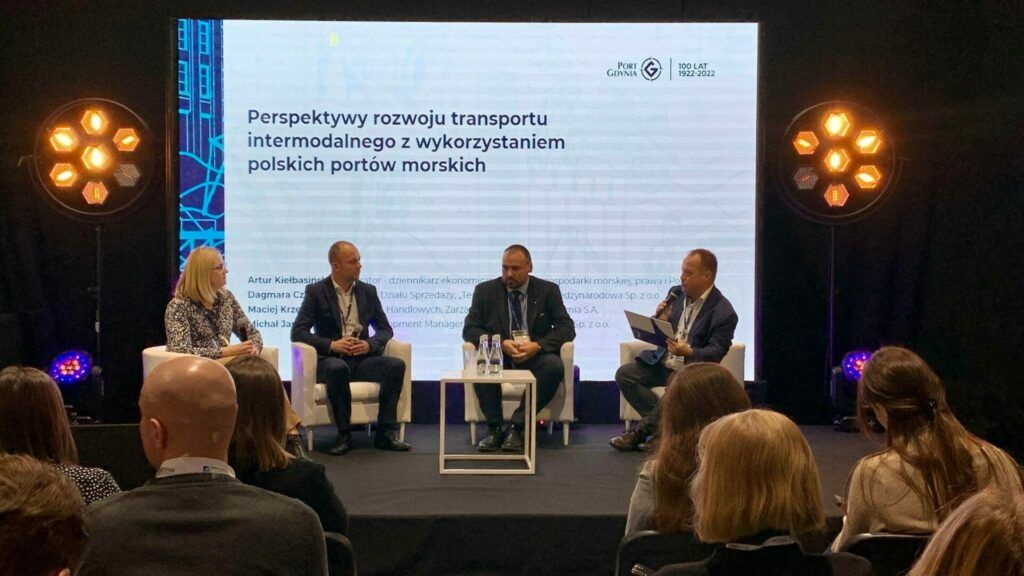For a dozen years or so, we have noted the development of intermodal transport in Poland involving railways and ports. In the long term, this trend will continue. We should expect a slowdown in the growth of intermodal transport next year, as forecasts point to a decrease in consumer demand and a possible slowdown in economic growth or even recession.
This is the key finding of the discussion entitled ‘Prospects for the development of intermodal transport using Polish seaports’, which took place today at the TransLogistica Poland trade fair in Warsaw. “If there is less freight to be transported, due to the crisis, this will be felt by logistics companies. Therefore, a huge role in reversing such developments falls to the state, if only through efforts to strengthen the zloty,” said Michał Jamioła, Business Development Manager at Langowski Logistics.
„In order for our partners to do good business, we will be completing or implementing key investments in the port and its surroundings,” stated Maciej Krzesiński, commercial director of ZPM Gdynia
Good prospects, but rail less competitive
Even in 2020-2021, a period of massive disruption to supply chains due to the covid pandemic, intermodal transport involving rail was growing in Poland. This trend continues this year as well. “And it will continue to grow, as it results from the logic of climate protection programmes adopted by the European Union and the search for ways to reduce greenhouse gas emissions through greater use of more ‘green’ means of transport than high-emission road transport,” said Michał Jamioła.
At the same time, he pointed out the conditions for its development. Railway intermodal transport is still less competitive than road transport in some respects, including in terms of the rates of transport services over closer distances, less flexibility, as well as longer lead times. “This is why trucks hauling containers from ports are still the first choice of customers,” Jamiola stressed. “But already in the case of heavy trains, carried over longer distances, rail is winning over trucks.”
This was confirmed by Dagmara Czapigo, sales manager at Terramar, but she pointed to possible changes. “EU legal requirements and the changing environmental awareness of businesspeople will certainly influence customer preferences. We are already seeing foreign-owned companies assuming that a certain percentage of containers transported must be carried by rail,” said Czapigo.
External conditioning
Maciej Krzesiński pointed out other determinants of intermodal transport development. Firstly, he recalled, there is a relatively lower level of containerisation of freight transport in Poland than in many Western countries. This may indicate how deep the growth reserves for containerised transport are in Poland.
Secondly, improving containerisation depends on investment on land. This depends both on further modernisation of the rail network, including the reconstruction of so-called passing loops, so that container trains do not have to wait for hours to let passenger trains pass, and on spot investments – including the construction or expansion of land terminals and railway sidings with appropriate equipment for handling containerised cargo.
“On the other hand, a greater share of rail in the handling of intermodal transport in our port depends on the completion of the modernisation of rail connections with the land, which will take place next year (the state of the works is advanced by approximately 80 per cent) and the modernisation of line number 201, which will increase its capacity and speed up the departure of trains,” added director Krzesiński. The Port of Gdynia Authority assumes that 25 per cent of all cargo will be exported from the port by trains in 2027, with a target of 50 per cent in further years.
Correcting transport corridors
It is clear from the debate that the Port of Gdynia Authority and its stakeholders recognise how the interest in transport is changing, from the still dominant east-west direction to that in the north-south direction (and vice versa). “The share of cargo handling to Scandinavian ports is increasing year on year,” said Director Krzesinski. “This is evidenced, among other things, by the fact that the port offers six weekly ro-ro connections and three daily ferry connections. We are also continuing to expand both terminals, ro-ro and ferry, in order to meet market needs.”
There is also growing interest in connecting the ports of the Tricity with the ports of the Adriatic. “This is logical, as north-south rail transport and vice versa significantly reduces time, in relation to sea transport around Europe,” added the director. A representative of Langowski Logistics pointed to another trend. “We are handling the first cargoes destined for Finland, reaching Poland via the New Silk Road and vice versa,” said Michał Jamioła. – Until recently, this was the domain of the ports of Hamburg and Rostock.
The role of hinterland
The debate recalled that the Port of Gdynia Authority had initiated the ‘Logistic Valley’ project. According to the assumptions, in the municipalities of Kosakowo and Rumia, warehouse and logistics facilities for the port are being created. Such are the needs of the market, not least because of the limited space in the port.
“In 2019, we opened a warehouse in the port with a capacity of 11 thousand square metres, but today it is used one hundred per cent, there is not enough space,” said Dagmara Czapigo. In general, Pomerania lacks storage space, so assuming further development of the port’s cargo handling, especially when the External Port is built, their construction outside Gdynia is needed. In her opinion, the location of warehouses there is not too distant from the port, while the prospect of further infrastructural investments will strengthen the assets of the port.
Director Maciej Krzesiński recalled that the key element of the Logistics Valley will be a new inland intermodal terminal, which will improve the handling of container terminals in the port, including the provision of short-term storage of cargo. This facility will also solve the problems of rail handling of the port’s growing cargo handling for many years, while at the same time increasing the share of rail in the port’s logistics service.
Source: https://intermodalnews.pl/2022/11/07/na-translogistica-poland-o-perspektywach-przewozow-intermodalnych/

ul. Rotterdamska 9, 81-337 Gdynia
Regon: 191920577 NIP: 9581323524 KRS: 0000082699



